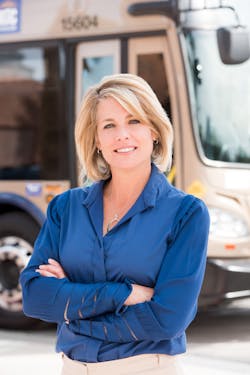Best Practices: Paratransit Innovation & Efficiency
Las Vegas, Nev.
Tina Quigley
General Manager
Regional Transportation Commission of Southern Nevada
Ride On-Demand: RTC of Southern Nevada and Lyft partner on Paratransit pilot program
Transportation options are growing, especially with the microtransit opportunities provided by transportation network companies (TNCs) like Lyft, which can provide same-day, on-demand and/or advance scheduled rides as an alternative to available conventional public transportation. As a public transit agency, the Regional Transportation Commission of Southern Nevada (RTC) wants to stay ahead of the curve and integrate modern transportation solutions to keep our 64 million annual passenger trips moving efficiently.
We wanted to find better ways to effectively transport customers and enhance their experience while saving money to reinvest back into our system.
In an effort to provide more accessible, flexible and cost-efficient residential transit services, the RTC recently launched a pilot program called Ride On-Demand with Lyft, the fastest-growing rideshare company in the United States, for a small select group of Paratransit riders. The Lyft pilot program will allow up to 200 Paratransit customers the ability to enjoy more flexible service and to be more spontaneous by scheduling rides on demand, something they previously could not do.
For the first time in Southern Nevada, Ride On-Demand will provide the traditional Paratransit customer with a same-day transportation option. Both ADA (Americans with Disabilities Act) and non-ADA service are provided. Lyft educates its drivers on how to assist passengers with collapsible wheelchairs as well as low-vision and hard-of-hearing/deaf clients to ensure the highest quality of service.
Rides can be scheduled directly through the Lyft app. Customers without access to a smartphone or require a wheelchair accessible vehicle can call RTC Customer Care seven days a week from 7 a.m. to 6 p.m. to request a ride via the program. SafeRide Health’s SafeRiderManager System provides a digital platform for the RTC to schedule rides directly onto the Lyft platform.
Ride On-Demand puts customers in control – they don’t have to schedule rides in advance, unless they would like to. They can get a ride on-demand and be picked up within minutes.
Not only does this pilot program enhance the customer experience, but it also allows us to save money that we can reinvest back into our transit system.
While Paratransit passengers only pay $3 per trip, it costs the RTC an average of $32 for a one-way trip. The pilot program provides increased flexibility for customers, but it does not increase passenger costs. In most cases, the customer continues to pay $3 one way.
The RTC subsidizes the ride up to $15 each way, and if the ride costs more than $18 total, the client has the option to pay the remaining balance or cancel the ride and use their Paratransit existing service. In setting the subsidy cost, we determined the average Paratransit ride is 10 miles one way, which is about $18 via Lyft.
“We’re excited to be partnering with RTC on this innovative new program, which for the first time will provide seniors and individuals with disabilities the freedom to book rides in real time, expanding their access to employment, education, healthcare and social activities,” said Yacob Girma, Lyft’s Las Vegas general manager. “Partnering with agencies such as RTC to support critical rider programs is a crucial step towards improving access to transportation in the communities we serve.”
And customers are pleased with the service Lyft provides. Raquel O’Neill has been a Paratransit client since 2000 when she was a freshman in college.
“I’ve taken close to 10 rides so far, and it’s amazing because of what it gives me – freedom,” said O’Neill. “I get to go where I need to go when I’m ready. I get to take my time with my son in the mornings because mornings are less hurried. I can make him breakfast and not worry that the Paratransit bus is waiting for me. I want to be respectful of the driver’s and riders’ time, but sometimes a five-year-old doesn’t understand that adults have busy lives. With a Paratransit bus transporting several passengers, I would have to schedule a pick-up an hour to 1.5 hours before the time I need to get to work. Now it only takes me 15 minutes, and all of my Lyft rides have arrived in five minutes or less when I’ve hailed them.”
“I’ve taken Lyft before opting into the pilot program, and I’ve noticed little changes in the app that’s been designed for the visually impaired,” she added. “There’s a fear factor with phones and apps among the blind because they’re afraid of making mistakes. But the Lyft app is simple to use, and the process is seamless. I feel completely independent and free.”
Continued positive customer feedback is critical as we evaluate the pilot program’s efficiency. Eventually, we’d like to open Ride On-Demand to more Paratransit clients like veterans, dialysis patients and the visually impaired. Success may also lead us to use TNCs such as Lyft to complement other transit services, including first-mile/last-mile connectivity with the transit system.
Mobility enables people to enjoy greater independence and freedom, just like Raquel. As a regional transit agency that provides both transit and Paratransit services, the RTC is always looking for innovative ways to improve service and move customers around the Las Vegas valley more efficiently and effectively.
As transportation options continue to evolve, public transit and Paratransit services in Southern Nevada will evolve too – but all the while, the RTC will still strive to provide customers with various mobility options and the highest quality of customer service possible.
702.676.1566 • @RTCSNV
Richmond, Va.
Jonathan Owens
Marketing & Public Relations Specialist
GRTC Transit System
Establishing relationships with the best providers in the industry is a critical step to improving paratransit efficiencies and offering a variety of mobility solutions. First Transit is the contractor for GRTC’s CARE and CARE Plus services, which provide public transportation access to individuals with disabilities who may not be reasonably able to use fixed-route bus service. First Transit assists with on-site management, corporate support, safety and training implementation and operations oversight. Partnering with First Transit allows GRTC to offer our customers a highly efficient and more cost-effective service.
Technology plays an essential role in improving efficiencies. GRTC uses Routematch software for scheduling and support. Collaborating with Routematch enabled GRTC to improve system speed and ensure ADA-compliant scheduling parameters for booking trips. As a result, we group more trips going to common destinations together and do not schedule trips lasting more than 90 minutes. Additionally, we will begin offering the flexibility of online booking for customers, facilities and caregivers. This should greatly reduce the number of call center inquiries and reduce hold times.
Soon, CARE and CARE Plus customers will also have the option to pay for trips using a preloaded card. When boarding, riders will tap the preloaded card at a validator and ride. This will be an easier payment option for most customers and will help GRTC manage and track revenue from trips more seamlessly.
In addition, vehicle inventory remains a key factor to improving efficiencies. As of March 2018, GRTC has 80 available cutaway vans and 8 sedans in our fleet. We have 23 new cutaway vehicles scheduled to be delivered this year to replace older vehicles.
GRTC also implemented a one-year pilot program in August 2017 called CARE On-Demand. GRTC partners with UZURV and Roundtrip to provide CARE customers with additional service options, such as scheduling a same-day, direct, non-stop trip anywhere within the GRTC CARE Service area. Riders may also reserve a ride up to 30 or 90 days in advance depending on the provider. Clients can enjoy the freedom of riding solo, riding with a guest (space permitting), with a Personal Care Assistant (PCA) or with a service animal. Customers can also request their favorite driver(s). Finally, this service provides ADA accommodations consistent with CARE and CARE Plus.
The Travel Training Program is an additional service we implemented to teach individuals how to ride public transportation safely and independently. Individuals who might otherwise be uncomfortable grow in their confidence and ability to ride fixed-route service self-sufficiently. In conjunction with the Travel Training Program, paratransit customers can ride local fixed-route service for free. Currently, there are approximately 16,000 paratransit riders each month who take advantage of free rides.
Our mission is to provide clean, safe and reliable transportation and to improve mobility and access throughout Central Virginia. With a commitment to providing exceptional customer service and responding to the needs of the communities GRTC serves, GRTC seeks to become the leading provider of world class transportation services and mobility solutions.
[email protected] • www.linkedin.com/in/jonathan-m-owens
York, Penn.
Richard Farr
Executive Director
rabbittransit
Regionalization Drives Paratransit Efficiency
Originally founded in 1974 by a coalition of local governments in York County, Pennsylvania, rabbittransit has grown into a 10-county, 5,062-square mile, regional transportation provider, with most of its growth happening since 2011. From 2011 to 2016, nine counties joined the York-based transit authority and it now manages and delivers shared ride services in all 10 counties. This advancement of regionalization has resulted in a host of efficiencies for paratransit.
Regionalization has allowed for administrative efficiencies as it relates to staffing and services. There is currently one regional administrative center for the 10 counties with nine transit depots. The administrative center houses a regional call center that facilitates reservations and application processing for all counties. A centralized dispatching unit is also located at this center to manage the paratransit operations. Additionally, specific functions such as finance, human resources and marketing are not duplicated across multiple counties.
rabbittransit has also been able to leverage regionalization for efficiencies in technology. As it continues to modernize its technology infrastructure, only one system per subject area needs to be deployed rather than invest in multiple technologies across multiple counties. Current technology sharing includes a single phone system, electronic complaint system, human resource information system, maintenance software system and paratransit scheduling software.
The areas of maintenance and vehicle utilization have benefitted from a regional approach.
Rolling stock is shared across all counties, which allows vehicles to be exchanged and moved for repairs as heavy maintenance is centralized. The collective expertise of a multi-county system allows for an aggressive preventative maintenance program that keeps the fleet operating far beyond FTA standards.
Operators and vehicles are utilized in a more productive fashion. Historically, rural passengers are transported to more urban centers for services, such as healthcare. Operators would wait idle for the passenger to finish their appointment for the return trip. Under the new model, operators are utilized in the area, assisting in better quality of service by helping to reduce wait and ride times, while at the same time reducing paid driver hours for dead time. Operational efficiencies have been found by removing municipal boundaries, allowing the closest vehicle to service the passenger. Often this dramatically reduces dead-head time and increases productivity.
Regionalization has also benefitted our paratransit riders in a very direct way. This demographic of customers is often a transient population. As they continue to move throughout the regional footprint, there is no loss of service as they do not need to be re-established into the system through an application process. This allows for continuity of care, which is incredibly important to a vulnerable population.
Through shared resources rabbittransit has been able to offer longer call center hours as well as Saturday availability. Customer facing materials such as ride guides and rider informational materials have been standardized and enhanced. It has been able to offer more hours of service and expand the geographical coverage area. Many of the counties that joined rabbittransit were very rural and the staff was small, wearing many hats. A regional model offers the ability to have specialized staff such as dedicated safety and training staff, who track performance measurements and assist in root cause analysis that leads to improving the rider experience.
After years of declining ridership and shrinking service areas, rabbittransit is seeing growth in its programs. Shared resources provide greater abilities to meet customers’ needs in an ever-changing environment. rabbittransit believes regionalization will better position it to adapt to changing technology that is certain to disrupt the transit industry.
[email protected] • www.linkedin.com/in/richard-farr-mobility/





